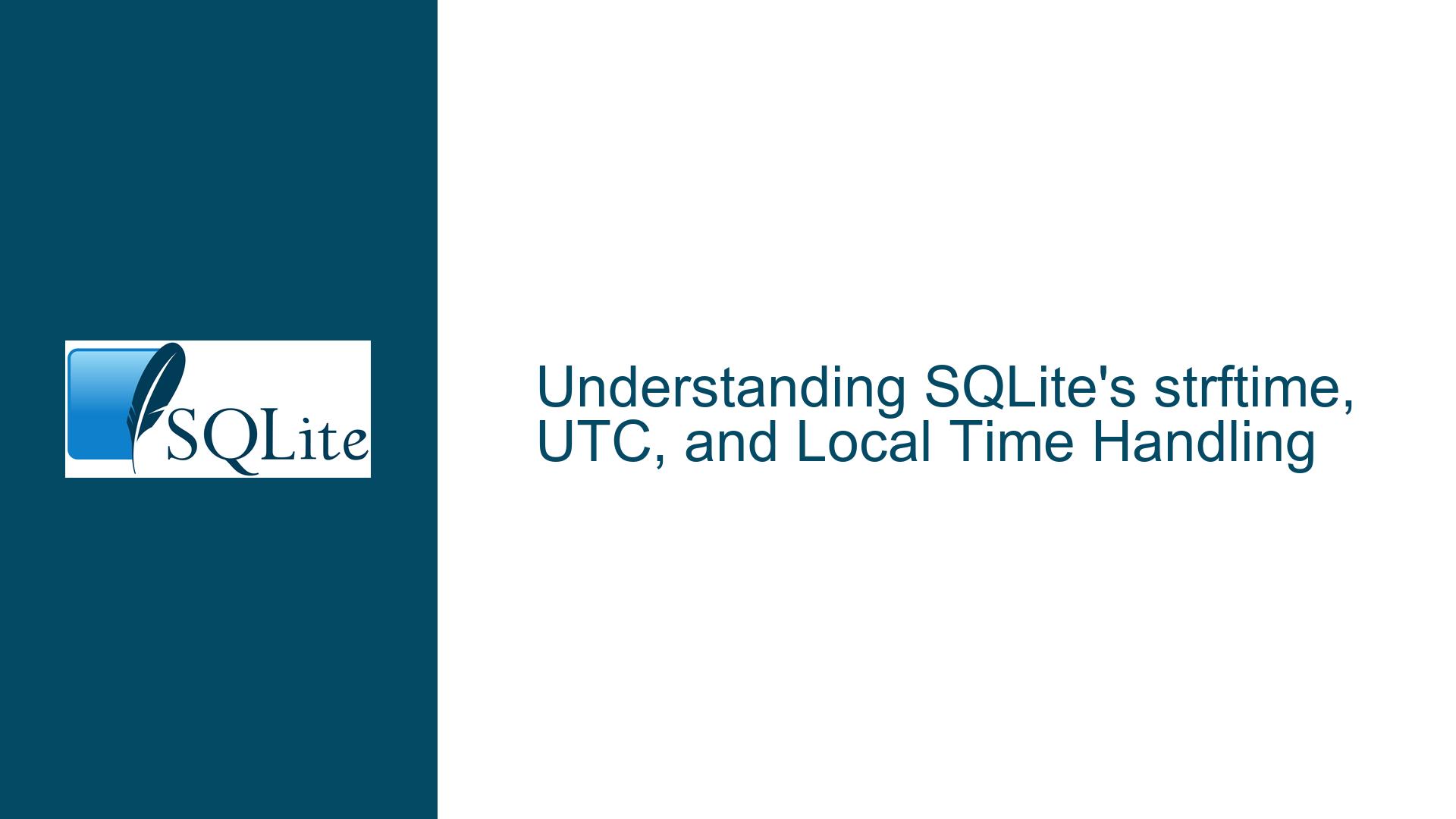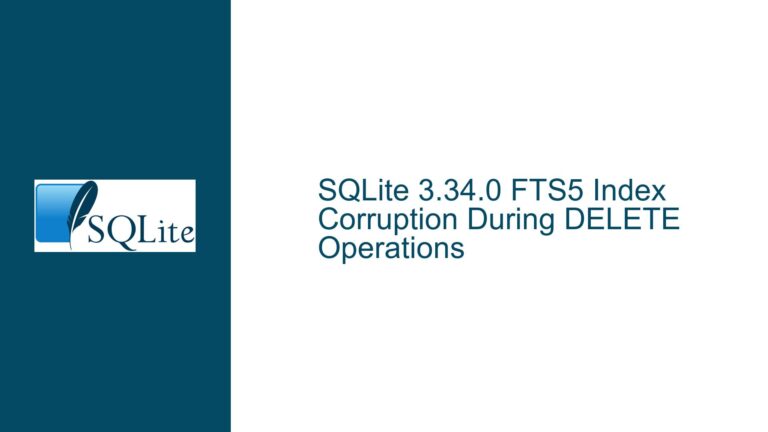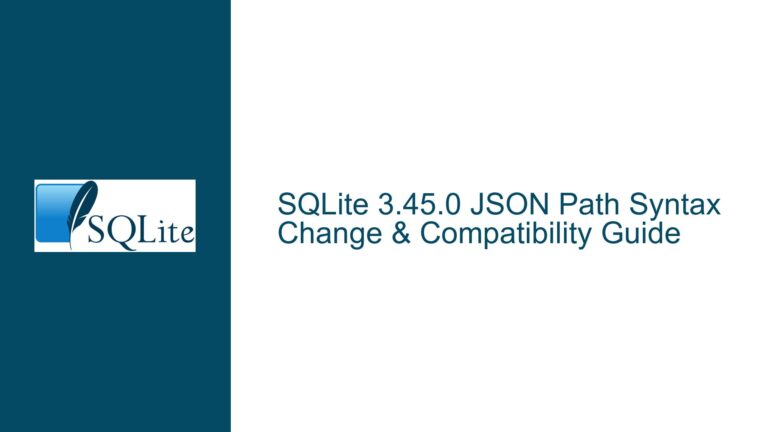SQLite’s strftime, UTC, and Local Time Handling
The Behavior of strftime with ‘now’, ‘localtime’, and ‘utc’ Modifiers
The core issue revolves around the behavior of SQLite’s strftime function when used with the 'now' keyword and modifiers like 'localtime' and 'utc'. Specifically, the confusion arises from how SQLite interprets and manipulates timestamps when these modifiers are applied. The strftime function is used to format dates and times, and its behavior can be influenced by the modifiers provided. However, the interaction between 'now', 'localtime', and 'utc' is not always intuitive, leading to unexpected results, especially when dealing with time zones.
When 'now' is used, SQLite returns the current time in UTC. This is a critical point because it sets the baseline for any subsequent modifications. The 'localtime' modifier then adjusts this UTC time to the local time zone by adding the appropriate offset. Conversely, the 'utc' modifier assumes that the time to its left is in the local time zone and converts it back to UTC by subtracting the offset. This dual role of 'utc'—acting as both a converter and a no-op under certain conditions—can lead to confusion, especially when the time to the left is already in UTC.
The issue is further complicated by the fact that SQLite’s 'utc' modifier does not always behave consistently. If the time to the left is explicitly marked as UTC (e.g., with a "Z" at the end), the 'utc' modifier becomes a no-op. This design decision, while historically consistent, can lead to unexpected results when users are not aware of these nuances. For example, if a user applies the 'utc' modifier to a time that is already in UTC, the result will be incorrect because the modifier will not perform the expected conversion.
Misinterpretation of Time Zone Offsets and Modifier Application
One of the primary causes of confusion in this scenario is the misinterpretation of how time zone offsets are applied when using the 'localtime' and 'utc' modifiers. The 'localtime' modifier is straightforward: it takes a UTC time and converts it to the local time zone by adding the appropriate offset. However, the 'utc' modifier is more complex. It assumes that the time to its left is in the local time zone and converts it to UTC by subtracting the offset. This assumption can lead to errors if the time to the left is already in UTC, as the modifier will incorrectly subtract the offset again, resulting in an incorrect time.
The issue is exacerbated by the fact that SQLite does not provide a clear mechanism to indicate whether a given time is in UTC or local time. This lack of explicit time zone information means that users must be careful when applying modifiers to ensure that they are working with the correct baseline. For example, if a user creates a timestamp using 'now' and then applies the 'utc' modifier, they may inadvertently convert the time twice, leading to an incorrect result.
Another factor contributing to the confusion is the way SQLite handles floating-point precision when dealing with timestamps. The strftime function can format timestamps with microsecond precision, but this precision can be lost if the timestamp is stored as a floating-point number. This loss of precision can lead to discrepancies when comparing or manipulating timestamps, especially when dealing with high-precision time measurements.
Correct Usage of strftime and Modifiers for Accurate Time Zone Handling
To avoid the pitfalls associated with SQLite’s handling of 'now', 'localtime', and 'utc', users should follow a set of best practices when working with timestamps and time zones. First and foremost, it is essential to understand the baseline behavior of the 'now' keyword, which returns the current time in UTC. Any subsequent modifiers should be applied with this baseline in mind to ensure accurate results.
When using the 'localtime' modifier, users should be aware that it converts a UTC time to the local time zone by adding the appropriate offset. This modifier is useful when displaying times to users in their local time zone, but it should not be used if the time is already in local time. Conversely, the 'utc' modifier should only be used when the time to its left is in the local time zone and needs to be converted to UTC. Applying the 'utc' modifier to a time that is already in UTC will result in an incorrect conversion.
To ensure that timestamps are handled correctly, users should consider storing timestamps as text rather than floating-point numbers. This approach preserves the full precision of the timestamp and avoids issues related to floating-point rounding errors. Additionally, users should be cautious when applying multiple modifiers to a timestamp, as the order in which modifiers are applied can affect the final result. For example, applying 'localtime' followed by 'utc' will result in a no-op, as the two modifiers cancel each other out.
In cases where precise time zone handling is required, users may want to consider using external libraries or custom functions to manage time zone conversions. These tools can provide more robust and flexible handling of time zones, reducing the risk of errors and ensuring that timestamps are accurately represented. By following these best practices, users can avoid the common pitfalls associated with SQLite’s handling of 'now', 'localtime', and 'utc', and ensure that their timestamps are accurate and reliable.
Conclusion
The behavior of SQLite’s strftime function with the 'now', 'localtime', and 'utc' modifiers can be complex and unintuitive, especially when dealing with time zones. Understanding the baseline behavior of 'now' and the effects of the 'localtime' and 'utc' modifiers is essential for accurate time zone handling. By following best practices and being mindful of the nuances of SQLite’s time handling, users can avoid common pitfalls and ensure that their timestamps are accurate and reliable.






